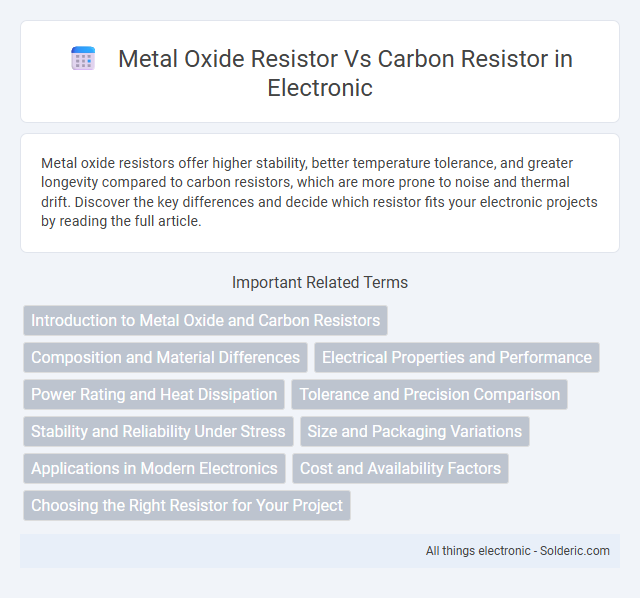Metal oxide resistors offer higher stability, better temperature tolerance, and greater longevity compared to carbon resistors, which are more prone to noise and thermal drift. Discover the key differences and decide which resistor fits your electronic projects by reading the full article.
Comparison Table
| Feature | Metal Oxide Resistor | Carbon Resistor |
|---|---|---|
| Material | Metal oxide film | Carbon composition |
| Resistance Stability | High stability | Lower stability, higher drift |
| Temperature Coefficient | Low (better at high temperatures) | Higher (less stable) |
| Power Rating | Typically 0.25W to 5W | Typically 0.125W to 2W |
| Tolerance | +-1% to +-5% | +-5% to +-20% |
| Noise | Low noise | Higher noise |
| Applications | Precision circuits, high-temp environments | General purpose, low-cost applications |
| Cost | Higher | Lower |
Introduction to Metal Oxide and Carbon Resistors
Metal oxide resistors utilize metal oxide films, providing superior stability, higher temperature tolerance, and enhanced reliability compared to carbon resistors, which rely on a carbon composition or film. Carbon resistors offer cost-effective options with moderate precision but are more prone to noise and drift under varying environmental conditions. Understanding these materials helps you select the appropriate resistor type for circuits requiring durability and accurate resistance values.
Composition and Material Differences
Metal oxide resistors are made from a ceramic base coated with metal oxide films, offering high heat resistance and stability. Carbon resistors consist of carbon powder mixed with a binder, providing lower noise but less thermal endurance. Your choice depends on the required durability and performance in specific electrical circuits.
Electrical Properties and Performance
Metal oxide resistors exhibit superior electrical properties with higher stability, lower noise, and better tolerance to high temperatures compared to carbon resistors. Carbon resistors typically have higher noise levels and less precise resistance values, making them less reliable in high-performance circuits. Your choice between these resistors should consider the required accuracy, power dissipation, and environmental conditions of the application.
Power Rating and Heat Dissipation
Metal oxide resistors typically offer higher power ratings, often up to 5 watts or more, compared to carbon resistors that usually max out around 0.5 to 1 watt. Their construction allows metal oxide resistors to dissipate heat more efficiently, improving reliability and stability under high power conditions. When selecting a resistor for your circuit, consider metal oxide variants if your application demands superior power handling and thermal performance.
Tolerance and Precision Comparison
Metal oxide resistors typically offer tighter tolerance ranges, often as low as +-1%, compared to carbon resistors, which usually have tolerances of +-5% or higher. This improved precision makes metal oxide resistors more suitable for applications requiring stable and accurate resistance values under varying environmental conditions. Temperature stability and lower noise levels in metal oxide resistors further enhance their performance over carbon resistors in precision circuits.
Stability and Reliability Under Stress
Metal oxide resistors offer superior stability and reliability under stress compared to carbon resistors, as they maintain resistance values more consistently at high temperatures and during voltage surges. Carbon resistors tend to exhibit higher tolerance shifts and potential degradation when exposed to prolonged stress or harsh environmental conditions. Choosing metal oxide resistors can improve the durability and performance of your electronic circuits in demanding applications.
Size and Packaging Variations
Metal oxide resistors typically offer smaller size options and more compact packaging compared to carbon resistors, making them ideal for applications requiring high power density and efficient heat dissipation. Carbon resistors generally come in bulkier sizes with simpler packaging, which can limit their integration into modern, miniaturized electronic devices. Understanding these size and packaging variations helps you choose the optimal resistor type for space-constrained circuit designs and specific application requirements.
Applications in Modern Electronics
Metal oxide resistors are preferred in high-temperature and high-power applications such as power supplies and automotive electronics due to their superior stability and resistance to oxidation. Carbon resistors, commonly used in low-cost, low-power consumer electronics and audio equipment, offer good performance in signal processing but are less reliable in harsh environments. Modern electronics increasingly favor metal oxide resistors for their durability and precision in circuits requiring high reliability and thermal endurance.
Cost and Availability Factors
Metal oxide resistors generally cost more than carbon resistors due to their enhanced stability and higher heat tolerance, making them preferred in applications requiring long-term reliability. Carbon resistors, being cheaper and widely available, are commonly used in low-cost, general-purpose electronics where precision is less critical. The widespread manufacturing of carbon resistors ensures abundant supply, whereas metal oxide resistors may have limited availability depending on specific industrial demand.
Choosing the Right Resistor for Your Project
Metal oxide resistors offer higher stability, better tolerance, and superior heat resistance compared to carbon resistors, making them ideal for applications requiring precision and durability. Carbon resistors, however, are cost-effective and suitable for general-purpose projects with lower power demands. When choosing the right resistor for your project, consider the required tolerance, power rating, and environmental conditions to ensure optimal performance and longevity.
Metal oxide resistor vs carbon resistor Infographic

 solderic.com
solderic.com